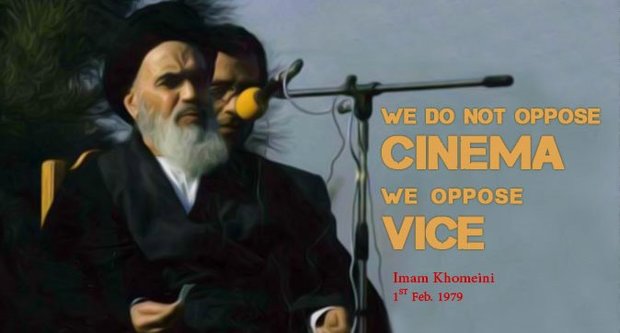- News code: 1254442
- Source: imam-khomeini.ir
Imam Khomeini, the leader of contemporary Muslim world, wanted to promote such an art and cinema which don’t contradict religious, spiritual and humanistic values.
Cinema like any other artistic creation by itself is the media and the complicated language of humanistic relations and social categories and the reflector of dreams and desires and problems and difficulties of the society as well as a prognosis and warning about risks and threats and hopes and the hampering desperations.
In this viewpoint, every artistic track is a window towards observation of the society and human. All movies by portraying feature of their surrounding community and human reflect their look and perception.
In fact between cinema and the society there institutes a conversation and dialogue in both sides of which the current word and speech is promoted in order to reveal its reality and truthfulness.
Imam Khomeini in position of a religious expert of arts
Imam on the day 23rd of month Ordibehsht1359 [of Iranian calendar] which coincides with spring season in a speech about radio and TV and finally around movies admires some of our good artists and directors and mentions:
“Thanks God, we have good announcers and writers. In my view, the films made by Iranians are better than the films of others. For example, the film “Cow” (The movie “The Cow” produced by Daryiush Mehrjū’ī prior to the victory of the Islamic revolution ) was having a lesson and an instructive theme. But now the films should be imported either from Europe or from America. Those are lewd films that please only to the open-minded Westernized people. The films imported from abroad are commonly imperialists. So avoid them unless they are cent-percent good. However this depends upon the people in change of such matters.” (Sahifeh-ye-Imam, Vol. 12, page 255)
COW has been made by Dariush Mehrjuii . Its outstanding cast are IzatollahI entezami, Jamshid Mashaykhi, Parviz Fanizadeh and Ali Nasirian, very well-known actors of past decades and all with long tenure in the industry now and then. COW which was of the first Iranian movies that attracted western and European cinema and gained their admiration, in Venice film festival of 1971 won the Fipresci prize. The scenario of it had been written based on a Azadaran Beyel a novel by Gholamhossein Saedi, who was of the leftist Iranian writers and had a background of activity with Azarbayjan Democrat faction.
The movie pictures the manic state ofMash Hassan(with skilful acting of Izatollah Intezami) the protagonist of the film after death of his Cow. A cow that was all the man ever had, and so everything ends for him after death of, since it washis whole possession.
Spread of the story about Imam’s position towards the movie Cow surprised everybody, a religious leader and a jurisprudent had given an expertise looking idea about a movie that was neither narrative nor documentary just like a critic which in the sphere of suspicion and doubt towards cinema seemed strange and unnatural.
Mehrjuii in response to a question about Imam’s favour to his film commented:
“Cinema in the atmosphere of the early years of revolution was a damned subject and people attempted to burning cinemas. Since they said, cinema was the place for spreading corruption. For this reason film production [in those years] fell down to zero level and cinemas were almost shut down. In such condition the Iranian T.V by a chance played the movie COW and his holiness Imam watched it and in a speech said: “We don’t say cinema is bad basically. Movies like COW can be culturally educative and upgrade thought and spirit of the audience”. This word of Imam was so decisive for Iranian cinema.”
This movie which has got a special place in the new wave cinema of Iran has a plot of complete fictitious and non-documentary.
Imam as a qualified jurist [Mojtahed] and a canonist watched the movie like an ordinary audience, a behaviour that looks odd and unprecedented in his class of jurisprudents and out of the fictitious track he presumed an educative message.
And it is also to say that this movie had been made in Shah’s era and the director and writer of it belonged to the particular generation of Iranian intellectuals free from any kind of religious tendency.
But none of these factors could ever affect Imam’s positive idea on the film. In fact Imam never judged on the director or the writer of the movie but evaluated the film itself and found its message educative and a successful sample of cinema and useful as an example and a model for film making in Islamic Republic which can same time produce a national identity for Iranian cinema in contrast with the flow of importing western movies.

